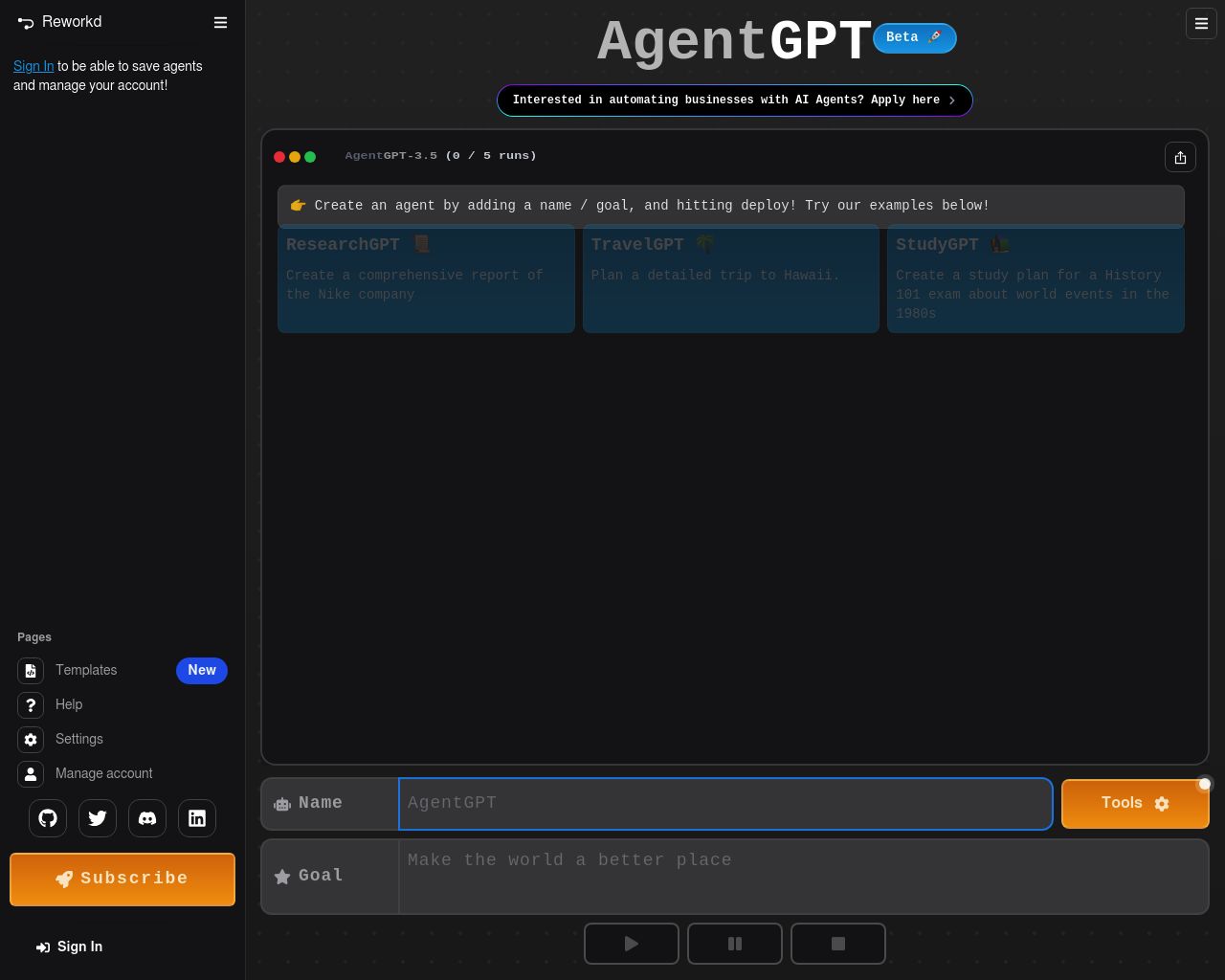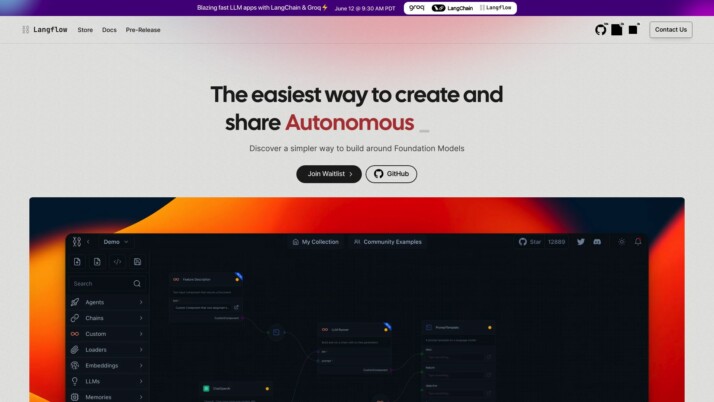AI agents revolutionize how businesses tackle complex tasks, offering unprecedented automation and efficiency. AgentGPT vs. Langflow stand out in this rapidly evolving field, each bringing unique strengths to AI development. AgentGPT excels in creating autonomous agents with advanced memory management, while Langflow’s visual builder simplifies AI workflow creation. This comparison explores their key features, highlighting how SmythOS combines and enhances these capabilities. We’ll delve into each platform’s approach to AI agent development, examining their strengths, limitations, and potential applications across various industries. Whether you’re a developer seeking powerful tools or a business leader exploring AI integration, this analysis will guide you through the landscape of AI agent platforms, helping you make an informed decision for your specific needs.
AgentGPT Overview
AgentGPT empowers developers to create and deploy autonomous AI agents directly in a web environment. Unlike traditional chatbots, these agents excel at tackling broad, goal-oriented tasks. The platform’s web-based approach sets it apart from local alternatives, offering a seamless experience for users across different technical backgrounds.
AgentGPT empowers developers to create and deploy autonomous AI agents directly in a web environment. Unlike traditional chatbots, these agents excel at tackling broad, goal-oriented tasks.


AgentGPT boasts a robust feature set, including user authentication, agent run saving and sharing, dynamic translations, and AI model customization. The platform’s web browsing capabilities expand its utility, while Stripe integration enables a lower-limit paid version. These features make AgentGPT versatile enough to handle tasks ranging from simple queries to complex operations.
A standout feature of AgentGPT is its use of vector databases for memory management. This allows AI agents to retain execution history and access long-term memory, significantly enhancing their functionality over extended periods. The platform’s accessibility via docker-compose, without requiring an API key for local runs, makes it developer-friendly. Its cloud offering scales efficiently, integrating seamlessly with tools like LangChain.
A standout feature of AgentGPT is its use of vector databases for memory management. This allows AI agents to retain execution history and access long-term memory…
While AgentGPT offers impressive capabilities, it lacks some advanced features found in other platforms. The absence of a visual builder or no-code editor may pose challenges for non-technical users. Additionally, the platform doesn’t explicitly mention features for explainability, debugging, or multi-agent collaboration, which could limit its applicability in certain complex scenarios.
Despite these limitations, AgentGPT’s commitment to open-source development and continuous evolution, driven by its user community, positions it as a valuable tool for developers and businesses looking to harness the power of AI agents. Its focus on simplifying web data extraction and automating data pipelines addresses crucial needs in today’s data-driven landscape, making it a compelling option for those seeking to optimize their operations through AI.
Langflow Overview
Langflow empowers developers to build AI applications with minimal coding. This open-source platform simplifies the creation of complex AI workflows through an intuitive drag-and-drop interface. Langflow caters to users across technical skill levels, from novices to experienced developers seeking rapid prototyping and deployment of AI solutions.
The platform’s strength lies in its visual approach to AI development. Users can leverage pre-built LangChain components, including Large Language Models and agents, to construct sophisticated workflows visually. This graphical method accelerates experimentation and prototyping, making AI development accessible to a broader audience.
Langflow empowers developers to build AI applications with minimal coding. This open-source platform simplifies the creation of complex AI workflows through an intuitive drag-and-drop interface.


Langflow offers robust features beyond its visual interface. The Command-Line Interface (CLI) provides advanced users granular control over project settings, including host configuration, port assignment, and logging levels. Security-conscious organizations benefit from enhanced login mechanisms and environment variable configurations, ensuring secure user authentication for public deployments.
API integration capabilities allow programmatic access to components and workflows, supporting asynchronous processing for efficient resource management. Developers can export and import flows as JSON files, enabling their use as Python objects or APIs. This flexibility extends to creating custom components using Python scripts, allowing users to tailor the platform to specific needs and integrate unique functionalities.
While Langflow excels in lowering the barrier to AI development, it may present a learning curve for users entirely new to AI concepts. Additionally, as a low-code solution, it might not offer the same level of granular control as high-code alternatives for highly specialized requirements. Organizations considering large-scale deployments should evaluate Langflow’s scalability for handling complex workflows in enterprise environments.
Feature Comparison
AgentGPT and Langflow take distinct approaches to AI agent development, each with its own strengths and limitations. AgentGPT excels in autonomous agent creation, leveraging vector databases for advanced memory management. This allows AI agents to retain execution history and access long-term memory, enhancing their functionality over extended periods. AgentGPT’s web-based platform and integration with tools like LangChain make it accessible and scalable.
Langflow, on the other hand, focuses on visual development through its intuitive drag-and-drop interface. This approach simplifies the creation of complex AI workflows, making it accessible to users with varying levels of technical expertise. Langflow’s visual builder and pre-built LangChain components enable rapid prototyping and deployment of AI solutions. However, it lacks some of the autonomous capabilities and advanced memory management features found in AgentGPT.
In terms of security, both platforms offer OAuth authentication, but Langflow provides more robust options for secure user management in public deployments. AgentGPT’s use of Docker for environment setup offers flexibility, while Langflow’s Command-Line Interface provides granular control over project settings. Neither platform explicitly mentions advanced debugging tools or multi-agent collaboration features, which could limit their applicability in complex scenarios requiring extensive troubleshooting or coordinated agent interactions.
Feature Comparison Table
| AgentGPT | Langflow | SmythOS | |
|---|---|---|---|
| CORE FEATURES | |||
| Visual Builder | ❌ | ✅ | ✅ |
| No-Code Options | ❌ | ✅ | ✅ |
| Explainability & Transparency | ❌ | ✅ | ✅ |
| Problem-Solving Capabilities | ✅ | ❌ | ✅ |
| Human-AI Interaction | ❌ | ✅ | ✅ |
| Work as Team | ✅ | ❌ | ✅ |
| Bulk Work | ✅ | ❌ | ✅ |
| Agent Work Scheduler | ✅ | ❌ | ✅ |
| SECURITY | |||
| Constrained Alignment | ❌ | ✅ | ✅ |
| Data Encryption | ✅ | ❌ | ✅ |
| IP Control | ❌ | ❌ | ✅ |
| COMPONENTS | |||
| Foundation AIs | ❌ | ❌ | ✅ |
| All other APIs, RPA | ✅ | ❌ | ✅ |
| Data Lakes | ❌ | ✅ | ✅ |
| DEPLOYMENT OPTIONS (EMBODIMENTS) | |||
| Deploy as API | ✅ | ❌ | ✅ |
| Staging Domains | ❌ | ✅ | ✅ |
| Production Domains | ❌ | ❌ | ✅ |
| API Authentication (OAuth + Key) | ✅ | ❌ | ✅ |
| Deploy as Site Chat | ✅ | ❌ | ✅ |
| Deploy as Scheduled Agent | ❌ | ✅ | ✅ |
| Deploy as GPT | ✅ | ❌ | ✅ |
| DATA LAKE SUPPORT | |||
| Sitemap Crawler | ❌ | ❌ | ✅ |
| YouTube Transcript Crawler | ❌ | ❌ | ✅ |
| URL Crawler | ✅ | ❌ | ✅ |
| PDF Support | ✅ | ❌ | ✅ |
Best Alternative to AgentGPT and Langflow
SmythOS stands out as the superior alternative to AgentGPT and Langflow, offering a comprehensive agentic AI automation platform that combines ease of use, extensive features, and unlimited use cases. Our platform empowers users to create and deploy AI agents with unparalleled efficiency and flexibility.
We provide a visual builder that surpasses both AgentGPT and Langflow in functionality and user-friendliness. Our drag-and-drop interface allows users to construct complex AI workflows without coding expertise, making advanced AI development accessible to a wider audience. This visual approach significantly reduces the learning curve associated with AI agent creation.
SmythOS stands out as the superior alternative to AgentGPT and Langflow, offering a comprehensive agentic AI automation platform that combines ease of use, extensive features, and unlimited use cases.
SmythOS excels in its feature set, offering capabilities that AgentGPT and Langflow lack. We support multi-agent collaboration, enabling teams of AI agents to work together on complex tasks. Our platform also includes advanced memory management, allowing agents to retain context and access long-term memory for improved performance over extended periods. These features enable the creation of more sophisticated and capable AI solutions.
Unlike AgentGPT and Langflow, SmythOS offers a wide range of deployment options. We allow users to deploy their AI agents as APIs, webhooks, scheduled tasks, or even integrate them into popular platforms like ChatGPT. This versatility ensures that AI solutions can be seamlessly integrated into existing workflows and systems, maximizing their utility across various business processes.
SmythOS sets itself apart with its focus on scalability and enterprise-ready features. We provide robust security measures, including data encryption and IP control, ensuring that AI implementations meet the stringent requirements of large-scale deployments. Our platform’s ability to handle complex workflows, support for various data types, and integration with multiple AI models make it the ideal choice for businesses looking to leverage AI technology effectively.
Conclusion
AgentGPT and Langflow offer unique approaches to AI development, each with distinct strengths. AgentGPT excels in creating autonomous agents with advanced memory management, while Langflow shines with its visual workflow builder. Both platforms democratize AI development, but with different focuses.
However, SmythOS emerges as the superior choice, combining the best of both worlds and offering additional powerful features. Our platform’s drag-and-drop interface rivals Langflow’s ease of use while providing the autonomous agent capabilities of AgentGPT. SmythOS goes further by offering unparalleled deployment flexibility, allowing users to create AI solutions once and deploy them across multiple platforms effortlessly.
SmythOS stands out with its extensive integration ecosystem, supporting over 300,000 integrations and a wide range of AI models. This versatility, combined with our multi-agent orchestration capabilities, empowers users to create sophisticated AI workflows that can tackle complex, real-world challenges. Our platform’s focus on explainability, debugging, and security ensures that AI solutions are not just powerful, but also transparent and trustworthy.
We invite you to experience the future of AI development with SmythOS. Explore our diverse range of AI-powered agent templates to jumpstart your projects, or dive into our comprehensive documentation to understand the full potential of our platform. Ready to transform your workflow? Create a free SmythOS account and start building AI agents with unlimited potential, backed by our 30-day money-back guarantee. Unleash the power of AI for your business today with SmythOS.